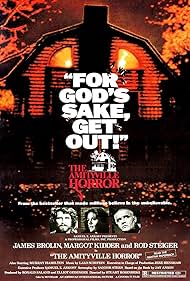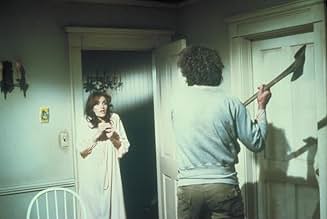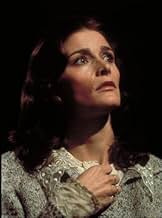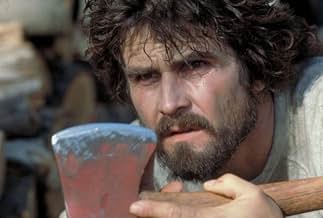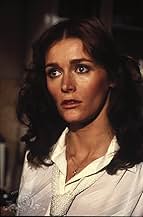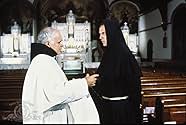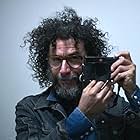Newlyweds and their children battle a demonic presence in their home.Newlyweds and their children battle a demonic presence in their home.Newlyweds and their children battle a demonic presence in their home.
- Nominated for 1 Oscar
- 8 nominations total
Featured reviews
Over the years, I have truly enjoyed "The Amityville Horror," a 1979 haunted house flick that has been critically, and unfairly, bashed. Since it's based on a true story, the critics have found that they dislike the movie based on their knowledge of the movie's inspiration. Now, here's my opinion: fiction or non-fiction, Stuart Rosenberg managed to make a fun, campy, and all around creepy horror film that resonates as one of the most famous haunted house movies ever created.
Everyone knows the legend about that house in Amityville, New York, the Dutch Colonial on 112 Ocean Avenue. The movie begins in 1974, when Ronnie DeFeo Jr. murdered his family in the house at 3:15 am, shooting them all in their sleep. A year later, George and Kathy Lutz bought the house and moved in with their three children and their dog, Harry. Aware of the tragedy that occurred in the home, George and his wife planned to fix it up and start a new life after their recent marriage. After all, "houses don't have memories." But then, things went wrong. Horribly wrong. And after 28 days, the family left the house and fled Amityville, never turning back.
Of course, Jay Anson's novel was a bestseller. I've personally read it myself, and it's written well. But there are several different variations on what happened during those 28 days, even with George and Kathy Lutz. So, for those of you who know the story before you watch the movie, it's hard to distinguish what is and isn't true. Some of you may not believe it at all. However, I am one of those people that believe in this account of a suburban haunted house, after watching rather truthful and intelligent interviews with the Lutzes and other paranormal investigators. But aside from that, what matters most about "The Amityville Horror" is how it works as a movie.
First of all, the setting means everything. Filmed in New Jersey, and not actually filmed in Amityville, the house is a particularly creepy abode to look at, especially during night scenes. Those two windows become a character all their own. They stare out into the night, and give the viewer the horrible feeling that they're being watched.
Also, there is definitely enough paranormal activity going on to keep you interested. However, the ghostly phenomenon doesn't start right away. In fact, it builds sporadically, creating a wonderful sense of dread. If you can appreciate a good build-up without much special effects(until the dynamite ending), then you will probably like the movie.
James Brolin and Margot Kidder are a joy to watch as George and Kathy Lutz. They are not perfect performances by far(there are moments when their performances go a little too over the top). But there are great things to see here between Brolin and Kidder. They have sincere moments together as husband and wife. Other times when things get frightening, their shock and fear comes off naturally. Then we are scared for George and Kathy. Basically, Brolin and Kidder give mostly good performances.
We also have Rod Steiger's performance as Father Delaney to judge. Sandor Stern's script has limited this character, and therefore, Steiger is not in the movie too much, but he makes the most with the screen time he has. In fact, he makes the role larger, and we're not just scared for the Lutz family, but for him also.
Obviously, some events in "The Amityville Horror" are slightly exaggerated when you compare them with the book's events or the perspectives of others who have experienced the haunting. But that doesn't make the movie any less entertaining. I look past its flaws, and embrace it for what it is: a cult classic that has gotten some damn good attention over the years. It's not a masterpiece, but I continue to love and believe in "The Amityville Horror."
Everyone knows the legend about that house in Amityville, New York, the Dutch Colonial on 112 Ocean Avenue. The movie begins in 1974, when Ronnie DeFeo Jr. murdered his family in the house at 3:15 am, shooting them all in their sleep. A year later, George and Kathy Lutz bought the house and moved in with their three children and their dog, Harry. Aware of the tragedy that occurred in the home, George and his wife planned to fix it up and start a new life after their recent marriage. After all, "houses don't have memories." But then, things went wrong. Horribly wrong. And after 28 days, the family left the house and fled Amityville, never turning back.
Of course, Jay Anson's novel was a bestseller. I've personally read it myself, and it's written well. But there are several different variations on what happened during those 28 days, even with George and Kathy Lutz. So, for those of you who know the story before you watch the movie, it's hard to distinguish what is and isn't true. Some of you may not believe it at all. However, I am one of those people that believe in this account of a suburban haunted house, after watching rather truthful and intelligent interviews with the Lutzes and other paranormal investigators. But aside from that, what matters most about "The Amityville Horror" is how it works as a movie.
First of all, the setting means everything. Filmed in New Jersey, and not actually filmed in Amityville, the house is a particularly creepy abode to look at, especially during night scenes. Those two windows become a character all their own. They stare out into the night, and give the viewer the horrible feeling that they're being watched.
Also, there is definitely enough paranormal activity going on to keep you interested. However, the ghostly phenomenon doesn't start right away. In fact, it builds sporadically, creating a wonderful sense of dread. If you can appreciate a good build-up without much special effects(until the dynamite ending), then you will probably like the movie.
James Brolin and Margot Kidder are a joy to watch as George and Kathy Lutz. They are not perfect performances by far(there are moments when their performances go a little too over the top). But there are great things to see here between Brolin and Kidder. They have sincere moments together as husband and wife. Other times when things get frightening, their shock and fear comes off naturally. Then we are scared for George and Kathy. Basically, Brolin and Kidder give mostly good performances.
We also have Rod Steiger's performance as Father Delaney to judge. Sandor Stern's script has limited this character, and therefore, Steiger is not in the movie too much, but he makes the most with the screen time he has. In fact, he makes the role larger, and we're not just scared for the Lutz family, but for him also.
Obviously, some events in "The Amityville Horror" are slightly exaggerated when you compare them with the book's events or the perspectives of others who have experienced the haunting. But that doesn't make the movie any less entertaining. I look past its flaws, and embrace it for what it is: a cult classic that has gotten some damn good attention over the years. It's not a masterpiece, but I continue to love and believe in "The Amityville Horror."
George (James Brolin) and Kathleen Lutz (Margot Kidder) buy a "dream house" in Amityville, New York for a "dream price". Unfortunately, the price was low because just a year before, the house was the location of the Ronald DeFeo Jr. murders--he killed his entire family while they were sleeping. As a priest, Father Delaney (Rod Steiger), blesses the home, he realizes with horror that something evil is lingering there. The dream house is turning into a nightmare.
Sometimes our affection for or aversion to an artwork that we've been exposed to a number of times over the years is inextricably enmeshed with our historical, emotional experiences, whether we admit this or not. For example, I strongly dislike soap operas, or indeed any dramas that resemble soap operas. This is probably due to the fact that for years my only exposure to soap operas was when I was home sick from school as a kid. These were the days before cable television and home video. In the middle of a weekday afternoon, you either watched soap operas or you didn't watch television. Subconsciously, I associate soap operas with a feeling of illness.
Likewise, Jay Anson's Amityville Horror novel appeared when I was still a teen. I loved it. I can still remember reading it in one long sitting--something I rarely did--in the family car as we drove from Florida to Ohio to visit relatives. I was excited when the film appeared, and liked it a lot at the time.
So although I can see many faults with Amityville Horror now, I still have a deep affection for it that triggers my brain to go into an apologetic mode and defend the film. I just can't bring myself to give it lower than an 8 out of 10, and even that seems low to me. But I can easily see how audiences lacking a history with the film might dislike it. It is relatively slow, uneventful and meandering--with a modern perspective, the pacing and "subtlety" are reminiscent of some recent Asian horror. At the same time, maybe paradoxically, scenery chewing has only rarely had a greater ally.
Just a couple days ago MGM released newly remastered widescreen versions of Amityville 1, 2 and 3. I haven't seen the film look this good since seeing it in the theater in 1979, and it probably didn't even look this good then. The first thing that struck me was how incredible much of the cinematography is. Director Stuart Rosenberg had an amazing knack for finding intriguing angles for shots and imbuing them with beautiful colors.
Unlike recent trends, Rosenberg's colors are not narrowed down to a single scheme. For example, in some shots, such as some of the interiors of the famed Amityville house, we get fabulous combinations of pale greens and yellows. In others, such as many exterior shots near the house, we get intense combinations of fall foliage colors. There are also a number of beautiful shots of the famed "eye window" exterior of the house in differently tinted "negative" colors.
Rosenberg evidences a great eye for placing his cast in the frame and shooting scenes to create depth and symbolism via objects that partially block or surround the frame. He also has a knack for creating winding, receding patterns of objects that enhance depth through perspective. My affection for this aspect of the film has little nostalgic attachment, as I didn't pay attention to such things as a kid (I didn't start noticing them more until I started painting, far into my adult years), and the positive aspects of the cinematography were hardly discernible on the previous, ridiculously bad pan & scan VHS release.
Of course, most people aren't watching a film like this for the aesthetics of the visual composition. This is one of the most famous haunted house films, after all. The horror is handled somewhat awkwardly, occasionally absurdly, but it still works well enough for me, as understated as it is (I'm not referring to the acting, just the horror "objects"). Aspects such as the ubiquitous flies reminded me of similar motifs, such as water, in Hideo Nakata's horror films (such as Ringu, 1998 and Dark Water, 2002). The beginning of the film, showing the Defeo murders, still has a lot of shock value, despite its relative post-Tarantino tameness. Most of the horror elements are more portentous, but they're regular and interesting enough to hold your attention, as long as you don't mind subtlety.
Subtlety, however, was the furthest thing from the cast's minds. Brolin, Kidder and especially Steiger shout their lines more often than they speak them. "Overacting" is not in their vocabularies. Kidder comments on an accompanying documentary that the horror genre walks a fine line between intensity and camp. That may or may not be true in general, but in Amityville Horror, camp is frequently broached. For me, it has a certain charm. I'm a fan of camp and "so bad it's good"; Amityville's performances often attain both.
The commentary on the new DVD is amusing given the 1970s publicity that the book and film depicted a true haunting and the subsequent, thorough debunking by persons such as Stephen Kaplan. Hans Holzer, a parapsychologist who has been involved with the story since the early days, and the author of a book upon which Amityville II was based, provides the commentary. He presents himself as an academic, but he obviously seems to have little concern for "objectivity" or skepticism. He not only still talks about the story as true, he invents supernatural excuses for the DeFeo murders and then some, barely mentioning detractors such as Kaplan.
If you haven't seen the film yet, you should base your viewing decision on whether you have a taste for deliberately paced horror as well as a tolerance for extremely over-the-top performances. The film is historically important in the genre, as well.
Sometimes our affection for or aversion to an artwork that we've been exposed to a number of times over the years is inextricably enmeshed with our historical, emotional experiences, whether we admit this or not. For example, I strongly dislike soap operas, or indeed any dramas that resemble soap operas. This is probably due to the fact that for years my only exposure to soap operas was when I was home sick from school as a kid. These were the days before cable television and home video. In the middle of a weekday afternoon, you either watched soap operas or you didn't watch television. Subconsciously, I associate soap operas with a feeling of illness.
Likewise, Jay Anson's Amityville Horror novel appeared when I was still a teen. I loved it. I can still remember reading it in one long sitting--something I rarely did--in the family car as we drove from Florida to Ohio to visit relatives. I was excited when the film appeared, and liked it a lot at the time.
So although I can see many faults with Amityville Horror now, I still have a deep affection for it that triggers my brain to go into an apologetic mode and defend the film. I just can't bring myself to give it lower than an 8 out of 10, and even that seems low to me. But I can easily see how audiences lacking a history with the film might dislike it. It is relatively slow, uneventful and meandering--with a modern perspective, the pacing and "subtlety" are reminiscent of some recent Asian horror. At the same time, maybe paradoxically, scenery chewing has only rarely had a greater ally.
Just a couple days ago MGM released newly remastered widescreen versions of Amityville 1, 2 and 3. I haven't seen the film look this good since seeing it in the theater in 1979, and it probably didn't even look this good then. The first thing that struck me was how incredible much of the cinematography is. Director Stuart Rosenberg had an amazing knack for finding intriguing angles for shots and imbuing them with beautiful colors.
Unlike recent trends, Rosenberg's colors are not narrowed down to a single scheme. For example, in some shots, such as some of the interiors of the famed Amityville house, we get fabulous combinations of pale greens and yellows. In others, such as many exterior shots near the house, we get intense combinations of fall foliage colors. There are also a number of beautiful shots of the famed "eye window" exterior of the house in differently tinted "negative" colors.
Rosenberg evidences a great eye for placing his cast in the frame and shooting scenes to create depth and symbolism via objects that partially block or surround the frame. He also has a knack for creating winding, receding patterns of objects that enhance depth through perspective. My affection for this aspect of the film has little nostalgic attachment, as I didn't pay attention to such things as a kid (I didn't start noticing them more until I started painting, far into my adult years), and the positive aspects of the cinematography were hardly discernible on the previous, ridiculously bad pan & scan VHS release.
Of course, most people aren't watching a film like this for the aesthetics of the visual composition. This is one of the most famous haunted house films, after all. The horror is handled somewhat awkwardly, occasionally absurdly, but it still works well enough for me, as understated as it is (I'm not referring to the acting, just the horror "objects"). Aspects such as the ubiquitous flies reminded me of similar motifs, such as water, in Hideo Nakata's horror films (such as Ringu, 1998 and Dark Water, 2002). The beginning of the film, showing the Defeo murders, still has a lot of shock value, despite its relative post-Tarantino tameness. Most of the horror elements are more portentous, but they're regular and interesting enough to hold your attention, as long as you don't mind subtlety.
Subtlety, however, was the furthest thing from the cast's minds. Brolin, Kidder and especially Steiger shout their lines more often than they speak them. "Overacting" is not in their vocabularies. Kidder comments on an accompanying documentary that the horror genre walks a fine line between intensity and camp. That may or may not be true in general, but in Amityville Horror, camp is frequently broached. For me, it has a certain charm. I'm a fan of camp and "so bad it's good"; Amityville's performances often attain both.
The commentary on the new DVD is amusing given the 1970s publicity that the book and film depicted a true haunting and the subsequent, thorough debunking by persons such as Stephen Kaplan. Hans Holzer, a parapsychologist who has been involved with the story since the early days, and the author of a book upon which Amityville II was based, provides the commentary. He presents himself as an academic, but he obviously seems to have little concern for "objectivity" or skepticism. He not only still talks about the story as true, he invents supernatural excuses for the DeFeo murders and then some, barely mentioning detractors such as Kaplan.
If you haven't seen the film yet, you should base your viewing decision on whether you have a taste for deliberately paced horror as well as a tolerance for extremely over-the-top performances. The film is historically important in the genre, as well.
I was but a timid lad of 14 when taken to a drive-in theater to see this incredibly effective horror film.There is no better monster to create a film around than the Devil himself.When Rod Steiger's character,Father Delaney is in the process of blessing the house,and was greeted by a resounding shout of "Get Out!",I almost took it literally,it was that effective.The Devil is indeed one unwelcome houseguest that is very hard to kick out,as you will see when you watch this film.James Brolin and Margo Kidder head a young family who are the new inhabitants of a home where brutal murders had taken place years before.Soon,strange happenings begin to haunt the family,as the house has trouble letting go of what had happened there.This movie is definitely in my top 10 horror films that I have seen,and if you enjoy being scared out of your wits,this film will do it for you.Give it a look!
After a gruesome mass murder takes place in a big house in a nice neighbourhood, the house is sold for a very affordable price to the Lutzes, an average stepfamily of five. Soon after moving in, strange things start occurring: doors, windows and furniture move by themselves, strange sounds are heard and the family members start behaving oddly. Especially George (James Brolin), the stepfather, becomes sullen and brooding over a couple of weeks, upsetting his wife Kathy (Margot Kidder) and her kids. A local priest (Rod Steiger) also notices something gravely wrong about the house, but doesn't seem to be able to help the Lutzes despite his efforts. As the eerie incidents keep getting more and more distressing, how will the Lutzes cope with the situation?
Based on Jay Anson's book about the experiences of the real-life Lutzes, the movie maintains a somewhat down-to-earth approach to the supposedly true story. It begins so slowly that I was already becoming quite disappointed with it, even though I'm generally supportive of creeping atmosphere in cinema. However, after a while it becomes obvious that it's actually better seen as a character study as opposed to horror: George's menacing change of nature can be seen as a reaction to the stressful life situation he's going through: raising a family, running a business, moving into a new house and getting the bills paid. The bearded James Brolin captures George's emotions very effectively, essentially carrying the whole film with his performance. Rod Steiger's character Father Delaney goes through an even more drastic phase of anxiety and Steiger plays the role with all the necessary intensity, especially during his desperate call for help in a degrading church. Margot Kidder's character receives less attention, but she does her job decently too.
The film quickly leads thoughts to other religious horrors of the era, such as The Omen and The Exorcist, but also bears a resemblance to The Shining, even though the latter only came out after it. A theme of a family man slowly losing his mind and, more obviously, an axe-swinging finale are more fascinatingly handled in Kubrick's film, but The Amityville Horror reaches a decent amount of suspense at its best too. The music by Lalo Schifrin is perfectly in tune with the atmosphere and when it finally starts in the last minutes of the movie, the action looks OK as well. The very ending comes across as rather abrupt though, even though the last shot of the family's car from afar suits the mood well.
In summary, I think The Amityville Horror is a watchable movie, but more so as a character study than a flat out horror. What the film loses in action and gore, it wins back in the actors' performances and music. When watched with this in mind, it may prove out to be an enjoyable experience, even if it's not ultimately quite as great as the horror classics mentioned in the previous paragraph.
Based on Jay Anson's book about the experiences of the real-life Lutzes, the movie maintains a somewhat down-to-earth approach to the supposedly true story. It begins so slowly that I was already becoming quite disappointed with it, even though I'm generally supportive of creeping atmosphere in cinema. However, after a while it becomes obvious that it's actually better seen as a character study as opposed to horror: George's menacing change of nature can be seen as a reaction to the stressful life situation he's going through: raising a family, running a business, moving into a new house and getting the bills paid. The bearded James Brolin captures George's emotions very effectively, essentially carrying the whole film with his performance. Rod Steiger's character Father Delaney goes through an even more drastic phase of anxiety and Steiger plays the role with all the necessary intensity, especially during his desperate call for help in a degrading church. Margot Kidder's character receives less attention, but she does her job decently too.
The film quickly leads thoughts to other religious horrors of the era, such as The Omen and The Exorcist, but also bears a resemblance to The Shining, even though the latter only came out after it. A theme of a family man slowly losing his mind and, more obviously, an axe-swinging finale are more fascinatingly handled in Kubrick's film, but The Amityville Horror reaches a decent amount of suspense at its best too. The music by Lalo Schifrin is perfectly in tune with the atmosphere and when it finally starts in the last minutes of the movie, the action looks OK as well. The very ending comes across as rather abrupt though, even though the last shot of the family's car from afar suits the mood well.
In summary, I think The Amityville Horror is a watchable movie, but more so as a character study than a flat out horror. What the film loses in action and gore, it wins back in the actors' performances and music. When watched with this in mind, it may prove out to be an enjoyable experience, even if it's not ultimately quite as great as the horror classics mentioned in the previous paragraph.
I went to HMV one day and decided to buy a horror movie. I had heard all about Amityville Horror. It was always on TV, but I never had the interest to watch it. So I bought the 2000 MGM DVD for $9.99. The movie is about a couple that moves into a new house, but little do they know, it is haunted. All of this was apparently a true story. Wonderful acting by Rod Stieger. This movie is not really a horror movie. It does not have the chills of a horror movie. The reason I never watched it was because I heard it was a bit of a bore. This movie is not what you may think it is. Don't go buying this if you think you will get a really scary movie. The DVD has a great picture. Probably a step up from the VHS version. If you are interested in the story of Amityville, then go out and get it. Do not expect a movie with blood and gore, because this movie is almost free of it. The 2000 DVD version is a bit of a disappointment in terms of features. Only the trailer is included. There are 8 sequels.
6/10
6/10
Storyline
Did you know
- TriviaJames Brolin's brother Brian Bruderlin was actually used for the image of the bearded man seen appearing from the 'red room' in the cellar (who is supposed to be Ronald DeFeo). The studio wanted someone who bore a close resemblance to Brolin and discovered he had a brother who shared a strong resemblance to the star. Brolin's brother was fitted with a fake beard for the part.
- GoofsWhen George & Kathy close Amy's window at night, you hear crickets chirping outside. This scene takes place in December. Crickets die in the winter but leave their eggs behind to hatch in the spring.
- Quotes
The House: GET OUT!
- Crazy creditsThis motion picture is based on the book "The Amityville Horror." Certain characters and events have been changed to heighten dramatic effect.
- Alternate versionsMost standard cable and commercial TV broadcasts show a very edited version of the movie with commercials to fit into a two hour time slot.
- How long is The Amityville Horror?Powered by Alexa
Details
- Release date
- Country of origin
- Language
- Also known as
- El horror de Amityville
- Filming locations
- 18 Brooks Road, Toms River, New Jersey, USA(Amityville house)
- Production companies
- See more company credits at IMDbPro
Box office
- Budget
- $4,700,000 (estimated)
- Gross US & Canada
- $86,432,000
- Opening weekend US & Canada
- $7,843,467
- Jul 29, 1979
- Gross worldwide
- $86,432,000
- Runtime1 hour 57 minutes
- Color
- Sound mix
- Aspect ratio
- 1.85 : 1
Contribute to this page
Suggest an edit or add missing content

